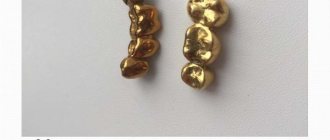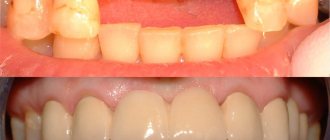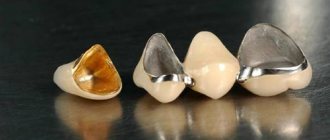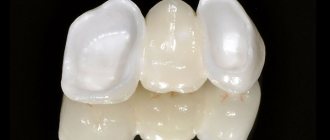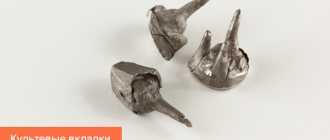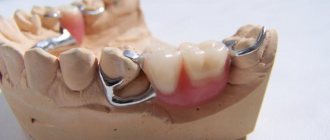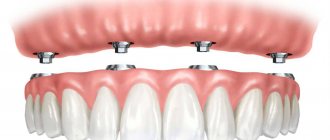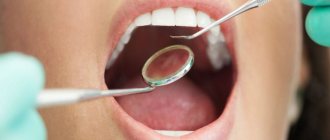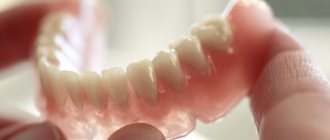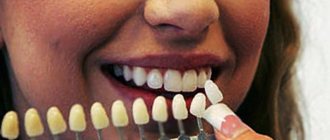Prosthetics with solid-cast bridges are now being used more and more often due to the possibility of eliminating a large number of defects using this method. To understand what this restoration option is, let’s consider how the structure is manufactured in a clinical laboratory setting, and what advantages and disadvantages it has.
What are solid bridges?
Manufacturing of a combined solid-cast bridge prosthesis
A bridge is a structure with supporting elements and several artificial crowns that replace missing teeth. The concept of “solid cast” implies that the structure is cast simultaneously.
The manufacture of a one-piece bridge prosthesis eliminates the adhesion of various elements to each other. The structure is made from casting various alloys, and most often it is gold, silver, palladium, chromium, cobalt.
Simultaneous casting of the prosthesis makes it possible to improve its quality in terms of strength and performance of basic functions. They are now valued in dentistry due to their improved manufacturing techniques and relatively low cost, which allows this restoration option to be considered by a large number of patients.
What they look like
A solid cast bridge resembles a bridge. The design consists of several connected crowns, which allows you to replace a defect on one side of the jaw. Two crowns from the prosthesis are supporting; they are fixed to healthy teeth. Externally, the metal frame has a specific color, which affects aesthetics, which is why this restoration option is being considered for replacing the chewing group of teeth.
Important! The main difference between a solid-cast bridge structure is that it is a single whole without joints or soldered elements.
Such products can be improved by combining different manufacturing options, spraying, and coating with a polymer overlay. This method of restoration is considered for the loss of chewing teeth.
This is what a solid-cast bridge prosthesis of chewing teeth looks like.
Bridges can be placed on the front teeth, but their appearance does not even closely match the natural tissues of the tooth, so more aesthetic options are selected to restore the “smile zone.” If the choice was made on a solid-cast bridge structure, then it is possible to cover it with a composite, which will make the appearance more natural.
Disadvantages and Alternatives
The main disadvantage of a bridge is that it requires grinding of teeth. If you want to avoid this, you can install a less convenient removable clasp denture, or still opt for implantation - it is more expensive, but guarantees a reliable and most aesthetic result for years.
In Moscow, you can get different types of dentures, including bridges, at our Kornident clinic. In our work we use modern materials - zirconium dioxide, the latest titanium implants, ceramics and alloys of the highest quality. Our equipment is also the newest and meets all standards. And thanks to the fact that all our specialists have not only higher education, but also certificates from foreign courses, we guarantee truly high quality treatment and an individual approach.
Materials used
For the manufacture of solid-cast prostheses, gold (both in pure form and sputtering) and stainless metals, or rather their alloys, are used.
The materials used can be combined, and such a prosthesis will be classified as combined or with veneer. The following materials are used as the base material for the manufacture of a solid-cast bridge:
- gold;
- silver and palladium;
- cobalt and chromium.
Structures made of chromium and cobalt can be improved by manufacturing in their natural form, gold plating, or ceramic coating to resemble natural hard tissues of teeth.
Classification
Bridges are one-piece structures that do not require the connection of individual elements by soldering. The technology eliminates the heterogeneity of the structure, as well as the occurrence of errors in the process of creating the structure, which ensures its strength and reliability during operation.
The materials used in the manufacture of the prosthetic system belong to several groups. Cast fixed prosthesis is usually created from gold, palladium-silver and cobalt-chromium alloys. Ready-made structures are suitable for installation in their natural form, but if necessary, it is possible to apply gold plating, as well as a ceramic or polymer layer that creates the effect of visual similarity to tooth enamel.
In modern dentistry, various casting techniques are used, among which are:
- Melting a metal workpiece using an electric arc;
- Processing the material using an oxygen-acetylene flame;
- High-frequency and electroslag casting methods.
The choice of technology is determined by the availability of appropriate equipment, as well as the specifics of the materials used.
Types
The following types of structures are distinguished:
- Coated with gold prostheses.
Sprayed bridge
- Without spraying - they look like polished metal.
Solid cast bridge without spraying
- With lining - has a composite or plastic lining on the front surface. There is a drawback - the risk of cracks and chips.
Solid cast bridge with veneer
- Combined - the design can be solid in the area of the chewing crowns and ceramic in the smile area to improve aesthetics.
Combined dentures
Preparation for prosthetics
Preparation for the installation of an orthopedic structure can be therapeutic, surgical, orthopedic and orthodontic. Types of preliminary sanitation can be combined, depending on the condition of the oral cavity and the type of defect.
How do you prepare for prosthetics at the dentist:
- Assessment of oral health.
- Carrying out professional cleaning to remove hard dental deposits.
- Carrying out anti-inflammatory therapy if necessary.
- Removal of carious cavities, treatment of pulpitis, periodontitis and other existing pathologies of teeth and mucous membranes.
- Depulpation of teeth (according to indications).
The surgical type of preparation includes the following activities:
- Removal of teeth that cannot be treated. Indications include chronic periodontitis, cysts, and pathological mobility of crowns.
- Removal of soft tissues due to their hypertrophy (hypertrophic gingivitis).
- Complex treatment of dentofacial pathologies.
Orthodontic preparation includes returning the normal bite of healthy teeth through the use of braces, aligners, and plates. Treatment is necessary to correct the position of individual abutment crowns and to create space in the oral cavity for fixation of the bridge structure.
The orthopedic preparation stage includes procedures such as:
- Making corrective aligners to move the advanced crown to the opposite side where the tooth is missing. In this way, the orthopedist creates a place to install the structure.
- Making functional mouthguards to relax the masticatory muscles. Such an event is indicated for hypertonicity in order to prevent breakage of the bridge after installation.
Artificial crown
An artificial crown is a type of fixed prosthesis made of metal alloys, porcelain, polymer, composite materials or combinations thereof, designed to cover the clinical crown of a natural tooth. They restore the anatomical shape of the tooth, the interalveolar height - the distance between the jaws and prevent further loss of hard tissue.
Artificial crowns
Indications for prosthetics with artificial crowns:
- Extensive dental defects of traumatic or carious origin when filling or prosthetics with inlays or veneers is impossible;
- Increased tooth wear, wedge-shaped defects;
- Anomalies in the shape and/or position of the teeth;
- Congenital disorders of the structure of hard tissues (hypoplasia and aplasia of enamel - less than normal amount or complete absence);
- Change in tooth color;
- Improving the fixation of removable dentures (creating a pronounced shape with expansion and contraction towards the neck for better connection with the retaining elements).
In addition, crowns are used as supporting elements of bridges, removable dentures, orthodontic and maxillofacial devices, and clasps for removable dentures.
Purpose of artificial crowns:
- Restorative – recreating the anatomical shape of the tooth, color and function;
- Support;
- Splinting – combined into groups and used to immobilize mobile teeth;
- Preventive – counter crowns on the teeth of the upper and lower jaws (antagonists) to prevent the progression of increased abrasion.
According to the technology, artificial crowns can be cast, stamped, obtained by firing or pressing ceramic mass, polymerization of plastics or composite materials, or milling.
In terms of material, they are all-metal (alloys of noble or base metals), porcelain, ceramic, polymer, composite, combined (metal-polymer, metal-ceramic, composite fiberglass). Typically, the crown material covers the stump on all sides (full crowns).
The choice of material and technology depends on the objectives of the individual clinical situation.
Their use requires preparation of teeth - preparation - creation of a stump shape that will ensure the possibility of application and fixation, as well as correct relationship with the gum edge and neighboring teeth. Retention occurs due to a layer of fixing cement.
The need to remove hard tissue is perhaps the only fatal drawback of this technology. Limitations in the use of crowns may be due to malocclusion pathology, increased tone of the masticatory muscles, the presence of dissimilar metals in the oral cavity, allergic reactions to materials, and young age.
Prosthetics on implants is in general similar to that on natural teeth (an implant is an artificial analogue of a root, onto which a crown is attached through an adapter - an abutment or directly). The only distinguishing feature will be screw fixation, which is impossible on natural teeth.
Advantages of artificial crowns:
- Increasing the physical and mechanical characteristics of the crown of a natural tooth due to the circular coverage of the dental stump with a single strength structure;
- The ability to reproduce or correct the appearance of the crown in the desired direction;
- The ability to perform the function of a supporting element of a fixed or removable prosthesis.
A generalized sequence of stages in the manufacture of artificial crowns (after the stages of examination, determination of indications, selection of type and preparatory measures) for natural teeth:
- Color determination;
- Obtaining impressions and diagnostic models (as needed - for example, in case of severe destruction of the crown and the need for preliminary modeling to obtain temporary crowns, tilting of the tooth);
- Preparation according to crown type and clinical situation;
- Obtaining final (working) prints;
- Fixation of temporary crowns;
- Obtaining working models;
- Wax crown modeling;
- Replacing wax with a permanent structural material;
- Model fitting, evaluation and correction;
- Oral fitting, assessment and correction;
- Temporary and permanent fixation.
Accordingly, when prosthetics on implants, when taking impressions, the position of the latter in the jaws will be recorded using transfers (impression modules).
Clinical and laboratory stages of manufacturing a bridge prosthesis
Stages and their features (K - clinical, L - laboratory):
- K - the dentist makes a diagnosis, selects the type of construction together with the patient, prepares the abutment crowns, after which impressions are taken.
- L - creation of a plaster model, selection of the color of the prosthesis, creation of a temporary structure.
- K - fitting the temporary product, checking occlusion.
- L - casting of a permanent bridge structure.
- K - fitting of the prosthesis.
- L - cladding or spraying.
- K - installation of the structure in the oral cavity, assessing the quality of its fit, fixation with special cement.
The prosthetic procedure will require 2 visits to the dentist’s office:
- First. The defect is assessed, the doctor considers the optimal restoration options, and clarifies with the patient which restoration method is preferable. On the first visit, the oral cavity is sanitized and the supporting elements are ground. The dentist takes impressions, sends them to the laboratory and places temporary aligners.
- Second. The dentist places a ready-made solid bridge, finds out how well it fits the patient, and whether there are any defects. When everything is in order, the structure is fixed with composite cement.
Important! When there are inflammatory pathologies of the mucous membrane or other relative contraindications, several visits to a specialist will be required until the problem is eliminated.
If the quality of the finished product does not match, it will require correction. In this case, prosthetics will also be extended over more than two visits.
Installation of a dental bridge: stages of the procedure
The process of manufacturing and installing the structure is simple and does not require additional actions aimed at violating the integrity of soft tissues, suturing, etc. The adaptation period is easy and painless. Despite its simplicity, the doctor and patient will have to go through several successive steps before the lost units are completely restored. On average, 3 visits to the dental office will be required.
Stage 0: sanitation of the oral cavity before the procedure
If during the initial examination the specialist suggested installing a bridge, he should carefully examine the oral cavity. One of the main conditions for prescribing treatment is the absence of carious lesions, inflammatory processes and other dental disorders.
The duration of this period depends on the condition of hard and soft tissues. If a person regularly visits the clinic for preventive purposes, it is likely that a routine cleaning will be required without applying filling material. If there are advanced diseases, they must be treated, and only then can you contact an orthopedist.
Stage 1: preparation of abutment teeth and production of a bridge.
When the dentist is sure that all units are completely healthy, a support is selected. The elements are ground, depulped, and the roots are filled.
Impressions are taken from the finished fastenings. They are sent to the dental laboratory.
While the permanent product is being manufactured, the patient will have to wear a temporary one with a plastic base. This may take 1-2 weeks depending on the workload of the institution and the complexity of the technological processes.
When there are not enough natural teeth, or they are of too poor quality, they cannot be cured and properly prepared for the procedure, implantation is indicated. Typically two anchor points are implanted.
Stage 2: installation of a fixed prosthesis
At the last visit to the dental clinic, the plastic structure is dismantled, and in its place is installed one made in the laboratory using impressions. The orthopedist checks how tightly the material adheres to the surfaces. There should be no obstruction to the closure of the jaws and no visible color differences, otherwise the artificial areas will be noticeable.
A full fitting, fitting and fixation is carried out. For greater reliability, special cement is applied.
If the client feels discomfort, prosthetics are not performed. The system is dismantled and returned to the laboratory for adjustment. If there are no unpleasant sensations, the treatment is completed.
Adaptation occurs even while wearing plastic. This means that the patient will be able to easily return to their normal lifestyle within a few hours. The doctor gives recommendations on the use and care of the product, prescribes routine examinations and provides other important information.
Installation process
The entire installation process of a solid cast structure includes the following activities:
- Sanitation of the oral cavity.
- Turning of abutment crowns using anesthesia. About 1.5 mm of tissue is removed. The crown is given a special shape for a secure fit of the prosthesis.
- Taking an impression.
- Trying on a temporary prosthesis with its subsequent fixation.
- Trying on a permanent structure and checking the quality of fit.
- Fixation of the permanent structure with cement.
Advantages and disadvantages
| pros | Minuses |
| Homogeneous design, lack of solder, which increases the strength of the product. Unlike other prostheses, solid ones almost never break, because there are no weak joints | Low aesthetics |
| High strength and durability | The cost is higher than a cast prosthesis |
| Tight fit to the tooth, which prevents food particles from getting under the crown, and this prevents secondary caries and destruction of enamel under the prosthesis, and also reduces the likelihood of damage to the structure | Great thermal conductivity |
| High functional efficiency due to precise modeling of support elements and intermediate parts | Risk of discomfort when eating hot food |
| No darkening factor in the structure in the soldering area | Cannot be determined in case of metal allergy |
| Wax can be used to thicken the walls of an orthopedic product. | The need to grind healthy crowns, which over time leads to their destruction due to malnutrition |
| The one-piece design is better tolerated by patients, the risk of prosthetic stomatitis is reduced | High load on abutment teeth can cause them to become loose |
Indications and contraindications for installation
The procedure is indicated when a person is missing one molar or 1-4 front incisors and canines. In this case, intact teeth should remain on the sides, which will subsequently act as supporting elements and withstand the greatest pressure when chewing food. Also, this cannot be avoided when the previous design has become unusable.
Despite all the advantages of orthopedic intervention, there is a list of cases when it is contraindicated:
- absence of more than 4 crowns;
- bruxism (involuntary grinding of the jaws, which is most often observed at night);
- malocclusion (before prosthetics you will have to undergo long-term orthodontic treatment);
- acute form of periodontitis or severe periodontal disease;
- pathological abrasion of the enamel layer;
- diseases of the skeletal system (for example, osteomyelitis);
- inflammatory processes in the oral cavity;
- poor hygiene preventing installation.
In addition, this also includes general contraindications to surgical intervention. These are problems with blood clotting, allergic reactions to drug components, manufacturing materials, chronic diseases during exacerbation, taking medications that prevent blood clots, and mental disorders.
Contraindications
One-piece denture in the mouth
There are relative and absolute restrictions that do not allow the installation of a solid-cast bridge. The first include conditions that this method of recovery completely excludes. Relative contraindications are considered individually.
A solid-cast bridge is not used in the following conditions:
- defects when more than 1 molar, 2 premolars and 4 incisors are missing;
- infectious and inflammatory pathologies of the jaw bones, including osteomyelitis and osteoporosis;
- psychological illnesses that do not allow the patient to take care of himself, as well as epilepsy;
- oncological diseases;
- pathologies accompanied by blood clotting disorders;
- allergy to the materials used or anesthetic substance.
Relative restrictions to this recovery option will be:
- teeth grinding at night or bruxism;
- acute period of inflammatory pathologies of the oral mucosa;
- poor oral hygiene;
- pathological abrasion of enamel;
- severe pathologies of periodontal tissues with frequent relapses;
- abnormal dental bite that cannot be corrected.
COMPARATIVE ASSESSMENT OF THE QUALITY OF MANUFACTURING SOLDERED AND SOLID DENTAL PROSTHESES
V.P. Zaitsev, N.N. Stepanov, V.E. Sumkin| Fig.1. Seam structure of a soldered prosthesis |
| Fig.2. Diagram of three sections of a soldered bridge. 1 – stamped crown; 2 – solder; 3 – cast intermediate part of the prosthesis |
The history of manufacturing fixed denture structures goes back to the distant past. For example, gold dentures found in the tombs of the Etruscans, who lived in the 9th–6th centuries BC, were made using the relatively high technology of that time and were very similar to modern dentures. Unfortunately, the technology for making prostheses of that time has not reached us. It was forgotten during the Middle Ages. In this era - an era of general decline in science and culture - manufactured dentures were primitive. Only during the Renaissance did the improvement of methods for making dentures begin, which was facilitated by the significant development of jewelry art of that time.
Dentures are a temporary form of assistance. Any prosthesis, due to wear and tear and changes in the conditions of the prosthetic bed, several years after fixing it in the mouth, must be made anew. Statistics give grounds to assert that patients who have fixed dentures are made see a doctor on average after 5 years, and those who have removable dentures are made – after 3–4 years. Therefore, the population’s need for dentures is a dynamic concept. Judging by the reporting data, it is impossible to provide for everyone in need with the existing technology for manufacturing prostheses.
If we compare the data on premature tooth extraction and data on their restoration with the help of prostheses, it turns out that currently in our country, with a quite well-developed system of dental care, denture care is provided to no more than 15% of those in need. Calculations show that to satisfy the population in dentures, about 50 million dentures must be produced annually, of which about 40 million are metal-based dentures. In fact, no more than 5 million are produced annually, and the quality of the prostheses is often unsatisfactory and does not meet modern requirements.
At the same time, despite the fact that in the last decade in world practice significant progress has been made in manufacturing technologies for various designs of dentures, in Russia up to 90% of dentures are manufactured using old technologies, i.e. when individual structural elements of the metal parts of dentures are made by stamping and then connected to each other by soldering using special solders.
In world practice, soldered ones have long been replaced by solid-cast denture designs. At the same time, dental casting occupies a leading place and accounts for up to 100% in the manufacturing technology of clasp and bridge dentures, microprostheses, plate dentures with metal bases, maxillofacial and orthodontic devices, as well as other metal devices for dentures.
The introduction of foundry production in dentistry allows the manual, labor-intensive process of “riveting” metal crowns without quality guarantees to be replaced by high mechanization. Naturally, this will lead to changes in the entire technological process of manufacturing dentures. At the same time, this will make it possible to obtain a significant economic effect and, most importantly, to ensure high quality manufacturing of dentures and thereby significantly improve the provision of dental care to the population.
1. EVALUATION OF SOLDERED DENTURES
More than 70 years have passed when, in the early 30s, industrial production of stainless steel began in our country, including grades such as 1Х18Н9Т, EN-95 (Citrine alloy). After a series of special studies, Soviet scientists proposed using these steel grades as the basis for the manufacture of metal elements of dentures.
Characterizing the first works of that time on the manufacture of dentures from stainless steel, one should note on the positive side the research of S.S. Assa (1932) and D.N. Citrin (1932, 1934, 1935), who managed to create solder for stainless steels and propose a technology for connecting structural parts of various types of dentures using the soldering method.
Assessing from the position of the current level the possibilities of carrying out the technological process of manufacturing soldered bridges and the results of clinical observations, there is reason to believe that the designs of dentures are unsatisfactory from both technological and mechanical strength positions and, in addition, do not meet biological requirements.
Soldering is defined as a technological process of joining metal parts into a single structure using another alloy that has a melting point lower than the melting point of the parts being connected by 50...100 oC and has maximum affinity. To lower the melting point of the solder, elements having a low melting point are introduced into its composition, i.e. an additive is introduced.
So, for example, to connect stainless steel products, an alloy is used, which includes silver, copper, zinc, bismuth, cadmium and other elements not included in stainless steel.
The structure of the seam resulting from soldering depends on the nature of the solder and the parts being soldered (see Fig. 1). There are three types of weld structure: mechanical mixture, solid solution and chemical compound. The best of them is a solid solution. It is obtained by chemical or physical affinity of the compositions of the parts being soldered and the solder. Therefore, to connect metal parts by soldering, it is necessary to know the composition of the alloys from which these parts are made, and according to this composition, select the necessary solder, which, when combined with the alloy, forms a solid solution. An ideal seam can only be obtained by soldering with the same alloy from which the parts being soldered are composed. However, this is impossible to do in practice, since to ensure mutual diffusion, the solder must be heated until completely melted, and at this temperature the soldered parts melt and lose the required shape.
Therefore, the solder cannot be identical in physical, chemical and mechanical characteristics to the base alloy from which the prosthetic parts are composed. The solder must also have a short period of latent heat of fusion, otherwise this will lead to the fact that by the time of soldering the entire mass of solder has not yet melted, or, conversely, it will overheat and some of its components will burn out, forming a porous seam.
In addition, solders with high surface tension do not spread well over the surface of the parts being soldered and penetrate especially poorly into the narrow gaps between the parts, which deteriorates the structure of the seam and its strength.
In Fig. Figure 2 schematically shows the structure of a soldered bridge made of stainless steel, on which three sections are distinguished: crown 1, solder 2 and cast intermediate part 3 of the dental prosthesis.
The sleeve from which the crown 1 was made was drawn and then stamped. Artificial teeth 3 were obtained by casting. The junction between crown 1 and intermediate part 3 was filled with solder 2, so the structure of all sections is not identical. Of these three areas, the most unsatisfactory is the solder.
Tests of solder carried out back in the 30s at the Research Institute of Non-Ferrous Metallurgy from the point of view of the strength of the connection of soldered parts showed that the solder has satisfactory mechanical properties, although it is unstable to the effects of even weak acids.
At the same time, an analysis of the literature data, which presents the results of experimental studies and clinical observations on the effects of various solder alloys on the biological environment, gives grounds to assert that from a physical and mechanical point of view, solder does not meet the requirements for dentures located in a biological environment .
The main disadvantages of solders are their low resistance to corrosion damage in the oral cavity, the difference in the electropotential relationship with the metals being soldered, as well as changes in the structure of the metal being soldered during the soldering process.
This leads to a number of provisions that are negative.
1. Metal oxides form in the oral cavity of people who use soldered dentures made of chromium-nickel steel. Depending on the nature of saliva, the composition of other metal products present in the oral cavity (dentures, metal fillings, inlays), as well as the individual characteristics of the body, the formation of oxides can be more or less pronounced.
Blackening of solder spots or the presence of sharply defined spots on the surface of steel prostheses indicates the presence of such oxides. At the same time, in the oral cavity of people using such dentures, a quantitative increase in microelements in saliva and the formation of heavy metal salts were noted, which negatively affects the secretory function of the stomach. The mechanism of influence of metal oxides on the body during electrolytic dissociation in the oral cavity has not yet been sufficiently studied, but their non-physiological nature is quite obvious and incompatible with the principles of preventive medicine.
2. In the oral cavity of persons using soldered dentures, a pathological condition occurs, called galvanism phenomena, which are associated with potential differences and can occur both in the presence of dissimilar metals or alloys, and due to the heterogeneity of the structure of one alloy.
In the presence of soldered bridges, both factors may arise that cause a potential difference, since these prostheses consist of different alloys - chromium-nickel steel and solder, and during their manufacture the structure of each of these alloys becomes heterogeneous.
When conducting a metallographic study of soldered bridges made of chromium-nickel steel, it was revealed that even with careful adherence to the technology, there are many unsoldered areas along the entire contact line. Micropores are found in the layer of solder separating them. Reducing the thickness of the solder layer, although it provides a stronger connection of the soldered parts, does not improve the structure of the alloy at the place of their connection, and the number of micropores in the solder layer in this case even increases. Both in the crown and in the intermediate part a two-phase steel structure is observed. There are areas of metal with precipitation of chromium carbides along the grain boundaries of the metal.
It is impossible to improve the structure of the alloy by heat treatment (recrystallization), since for this the prosthesis must be heated to a temperature of 1,000–1,100 °C, and this will lead to deformation and separation of its parts.
As a result of the phenomena of electrolytic dissociation, porosity and unsoldered areas, insufficient strength is created. This leads to a reduction in the period of use of such prostheses due to the separation of the intermediate part from the crowns.
From a mechanical point of view, soldered prostheses are not strong enough. During the soldering process, crowns and artificial teeth heat up most in the melting zone of the solder, and individual sections of the bridge heat up to a lesser extent. Uneven heating changes the structure of the crystal lattice of the cast intermediate part of the prosthesis. For example, chromium-nickel stainless steel changes its phase state at the soldering point at a temperature of 900 °C. In somewhat distant areas in the temperature range of 600–800 oC, precipitation of carbides dissolved in the alloy occurs. In areas located even further away, the compound of carbon and chromium is concentrated. The metal becomes brittle. The formation of a two-phase structure, in turn, causes the occurrence of intercrystalline corrosion, which intensifies with mechanical load of dentures in the electrolyte environment of the oral cavity, as a result of which bridge dentures break.
In addition, after soldering parts of the prosthesis, the total result of shrinkage of the solder leads to significant deformation of the frame of the bridge, which makes it difficult to fix it in the oral cavity.
From numerous literature data it is known that from a biological point of view, the quality of soldered prostheses is also unsatisfactory. Solder is sufficiently stable only in alkaline environments. In an acidic environment, which often occurs when eating food or due to changes in the pH of saliva, solder is unstable and chemically active elements are released from it. Thus, the concentration of iron, cadmium, copper, bismuth and other elements in human saliva can often exceed the norm by more than three times. In combination with other elements that make up saliva, they cause the occurrence of non-physiological electrolytic processes in the oral cavity. Due to the structural variety of the areas of soldered prostheses, the difference in potentials often exceeds 100 mA, and this can cause such symptom complexes in patients as a metallic taste, a burning sensation of the mucous membrane, a perversion of taste, etc. Electrolytic dissociation, in turn, enhances the corrosion process metals and leads to the formation of new oxides. In addition, solder oxides diffuse into the plastic lining of the crowns of artificial teeth and change their color.
From a technological point of view, when producing crowns by stamping, there is an inappropriate change in their thickness in different areas. During the process of drawing and stamping sleeves, the areas in the transition area between the chewing and cutting surfaces become thinner the most. Then, in these same areas, the metal is significantly ground off during machining and polishing. As a result, the thickness of the side wall of the crown between the equator and the gingival margin is almost 2 times greater than the thickness in the area undergoing the most treatment.
If we consider the clinical stages of manufacturing stamped-soldered prostheses, they provide for up to 5 patient visits to the doctor:
1 visit:
Preparation of teeth and taking impressions for the manufacture of stamped and soldered crowns.
2nd visit:
Trying on stamped crowns and their adjustment, as well as taking an impression to make the soldering of the intermediate parts of the prosthesis (cast teeth).
3rd visit:
Trying on unpolished stamped-soldered bridge structures and their adjustment.
4 visit.
Fitting of polished stamped-soldered structures of bridges and structures with their subsequent fixation.
5 visit.
When spraying dentures, the production of dentures takes from 20 to 30 days.
Thus, analyzing the above, we can draw the following conclusions, namely:
1. Currently, stamped crowns and soldered bridges do not meet the necessary modern requirements, since the stamping technique does not allow for accurate production of the crown.
2. The presence of dissimilar alloys and metals in a soldered bridge prosthesis leads to the phenomenon of galvanism in the oral cavity.
3. At the place where denture elements are soldered, breakage very often occurs.
4. The manufacturing process of various elements of a stamped-soldered denture involves the use of strong acids.
2. EVALUATION OF SOLID DENTURES
As mentioned above, the method of making solid dentures from gold has been known for a long time, but due to the high cost it has not received mass distribution.
Modern dental prosthetics is developing in two directions:
1. Research and use of materials that would have certain physicochemical, mechanical and biological properties, but at the same time would be cheap and available for mass use.
2. Individual production of a denture design that would most fully and optimally compensate for the defect in the dentition.
In this regard, in dental practice, metal alloys are used, parts of which are made by preliminary individual modeling of reproductions from modeling materials with the subsequent replacement of these reproductions by precision casting.
Therefore, a major role in the manufacture of dentures that meet modern requirements for them belongs to foundry processes for the production of dental casting.
However, it should be noted that casting metal parts of a denture is a complex technological process consisting of the following stages:
– making a wax reproduction of the part (wax model);
– installation of gates and creation of a casting block;
– preparation of the mixture used to form the facing layer of the model;
– covering the wax reproduction of the part with a facing mass;
– production of injection molds;
– melting wax from the casting mold, followed by drying and firing of the casting mold;
– melting of a dental alloy followed by pouring the molten metal into a casting mold;
– cooling the casting with its subsequent release from the molding mass and gates;
– if necessary, heat treatment of cast parts.
– polishing, fitting, etc.
Consistent and careful implementation of the above stages of manufacturing denture parts using the lost-wax casting method is a guarantee of ensuring high quality of the cast denture part, which can only be achieved by carefully performing the listed points in accordance with existing techniques.
It should be especially emphasized that to ensure high-quality production of metal parts of dentures, the method of melting the alloy from which the part is cast is important.
In dental practice, various methods of metal melting are used: electric arc melting, oxygen-acetylene flame melting, electroslag casting, and high-frequency casting. Melting metal with an electric arc and an oxygen-acetylene flame is an open type of melting. In the first case, the temperature regime is maintained using electrodes made in the form of graphite coals; in the second, melting occurs due to direct contact of the flame of a burning mixture of acetylene and oxygen with the melting metal. Melting metal in electric furnaces using high-frequency currents is a closed type of smelting.
However, despite the fact that the above methods of metal melting make it possible to provide the required temperature sufficient to melt alloys used in dental practice, the structure and properties of these alloys after casting change significantly.
For example, when melting chromium-nickel steel with an electric arc, the percentage of carbon and oxygen in the alloy increases, and on the microsection many foreign inclusions are found, which by their nature can be attributed to oxygen and carbon compounds. On microsections of parts cast using a high-frequency furnace, foreign inclusions are not detected, and the structure of the alloy is close to homogeneous.
When interacting with a 50% solution of hydrochloric, acetic or lactic acid, castings are highly stable after melting in high-frequency electric furnaces. Castings after melting with an electric arc are less resistant to acids, which is explained by the increased content of carbon and Eoxygen in these samples.
The results of a study of melting cobalt-chrome steel using an electric arc or an oxy-acetylene flame showed that the content of carbon and oxygen in it increases (carbon content often exceeds 0.4%). When melting the same grade of steel in high-frequency furnaces, the percentage of carbon in the alloy does not change significantly.
The nature of cooling of the alloy after pouring into the mold has a significant impact on the hardness, ductility and uniformity of the metal structure.
High hardness, low ductility and pronounced heterogeneity of the alloy structure (presence of carbide formations) are observed during slow cooling of the casting. With rapid cooling, the alloys retain a single-phase state without visible carbon inclusions, low hardness and good ductility are noted. This is explained by the fact that when the casting is slowly cooled, there is enough time for diffusion processes to occur, promoting the formation of carbide systems. With rapid cooling, this process is suppressed and carbides do not have time to form. Consequently, to ensure a homogeneous structure of the alloy after casting and maintain its high physicochemical and mechanical properties, it is most advisable to smelt the metal in high-frequency casting-melting furnaces, followed by rapid cooling of the cast parts.
High frequency induction melting machines provide higher casting quality. First of all, carburization and burnout of some components of the alloy are eliminated, the gap between the period of complete melting of the metal and its pouring into the mold is eliminated, and this eliminates the need for higher heating of the alloy after melting in order to compensate for the cooling of the mass during the period of connecting the cuvette to the injection mold. The molten alloy fills the hot mold under high pressure of centrifugal force, which makes it possible to compensate for the shrinkage of the alloy by expanding the molding mass when it is heated. In addition, the constant pressure of the centrifugal force exerted on the cooling metal sharply reduces the possibility of the formation of shrinkage cavities, which arise due to the fact that the outer surface of the metal has already hardened and a hard crust has formed, while the inner one is still cooling and a mass rupture is obtained, i.e. sink. When casting dental parts in centrifugal casting installations, the alloy is poured into a mold heated to 800–900 °C, so it cools more evenly. The greater the difference in temperature heating of the mold and the alloy, the greater the number of shells, while overheating of the alloy is allowed no more than 100 °C above its melting point.
Thus, dental casting requires maximum attention even if all basic foundry rules are carefully followed. Cast parts or prostheses must be subjected to appropriate additional processing to improve their quality.
As already indicated, to ensure uniformity of the alloy structure, cast parts should be subjected to rapid cooling. However, even with rapid cooling of castings at a temperature of 600–800 °C, some heterogeneity in the alloy structure may occur. Firstly, at this temperature the most favorable conditions are created for the combination of carbon and chromium (formation of chromium carbides). This manifests itself more intensely, the higher the percentage of carbon in the alloy. Secondly, during rapid cooling, not all iron has time to transition from the $- to -state, and therefore is in a two-phase position. All this increases the electrical activity of prostheses and reduces their strength.
The resulting heterogeneity of the alloy structure can be eliminated by heat treatment of the part or prosthesis, if they have not been soldered and the percentage of carbon in them is within acceptable values.
When carrying out a metallographic examination of solderless bridges cast in chromium-nickel stainless steel, immediately after casting and after appropriate heat treatment in the intermediate links of the prostheses that have not undergone heat treatment (especially in the crowns of these prostheses), a two-phase structure of the steel is revealed. There are also areas of metal with precipitation of chromium carbides, which reduces the mechanical and physicochemical properties of the metal, causes intercrystalline corrosion and increases the electrical potential of prostheses.
The accuracy of casting, the smoothness of its surface and the purity of the alloy depend both on the heat resistance, dispersion and other qualities of the facing layer, and on a number of other factors. An important role is played by the change in the shape of the metal during the transition from the molten state to the solid state (shrinkage). Shrinkage of the metal or alloy is inevitable in foundry technology, but it can be compensated for by selecting a molding compound that has an expansion coefficient that is closest to that of the alloy. It should be remembered that the expansion coefficient of the molding mass depends not only on the physical properties of each of the ingredients, but also on the degree of heating, as well as on the amount of plasticizer taken to dilute the mass.
Molding compounds, the basis of which are quartzites, have the greatest expansion when heated to a temperature of 800–900 oC. The greater the degree of expansion, the less water is taken to dilute the mass, i.e. the denser the consistency of the dough. With large dilutions of the molding mass with water, maximum expansion is observed at a lower temperature, but the degree of expansion is significantly lower compared to a densely diluted molding mass.
To achieve the greatest thermal expansion of the mold, necessary to compensate for metal shrinkage, it is advisable to use dry quartz sand as an external filler for the casting mold.
From a mechanical point of view, cast abutment crowns that are part of a solid-cast bridge do not have the elastic deformation inherent in stamped crowns and soldered bridges. Cast dentures sag less, which creates conditions for reliable protection of the aesthetic coating made of plastic or metal-ceramics. When making crowns, it is possible to create zones of local thickening by layering wax, which provides mechanical resistance to the perception of functional load.
From a biological point of view, one-piece prosthetic structures also have advantages. The homogeneity of the metal structure and the absence of solder ensure a decrease in the intensity of electrochemical processes in the oral cavity and a decrease in the amount of microelements washed out into saliva, which can act as haptens and have an allergic effect on the human body.
Clinical studies give reason to believe that in many patients who come to the clinic with symptoms of galvanosis, after removing soldered dentures from the oral cavity and fixing solid dentures made from the same alloy, the phenomena of metal intolerance disappear.
In addition, the clinical stages of manufacturing solid dentures, compared to the clinical stages of manufacturing stamped-soldered dentures, involves only three visits, namely:
1st visit: Preparation of teeth, taking impressions for the manufacture of temporary protective structures and fixation of temporary protective structures.
2nd visit: Fitting of polished solid cast structures and fixation of the prosthesis.
3rd visit. When spraying dentures, the production of dentures takes from 3 to 10 days.
From a technological point of view, the advantages of solid-cast bridges are undeniable. Lost wax casting in industry all over the world is currently one of the most promising processes for processing metal into products of complex shapes. Currently, in most dental industries in the world, the soldering process is excluded. For more than 30 years, the curricula of foreign universities that train dental specialists have not included a section on the technology of manufacturing soldered denture structures.
Thus, from the above comparative analysis of the manufacture of dentures using the stamping method followed by soldering and the casting method, the following conclusions can be drawn:
1. Producing dentures by casting makes it possible to obtain more uniform properties of the metal of the denture, which eliminates electrochemical processes in the oral cavity;
2. Dentures allow you to most fully compensate for the defect in the dentition, since cast crowns are more accurate, tightly cover the neck of the tooth and do not injure the gum tissue;
3. Dentures are reliably protected by aesthetic coatings made of plastic or metal-ceramics.
4. The mechanical strength and chemical resistance of dentures increases, and, consequently, their service life.
5. The introduction of casting technology into dental practice makes it possible to reduce the number of both clinical and laboratory stages in the manufacture of solid-cast bridges, which allows not only to obtain a significant economic effect, but also to significantly improve the quality of manufacturing dentures.
6. The technology for manufacturing solid-cast bridges does not involve the use of strong chemicals (acids, alkalis, etc.), which improves the working conditions of dental technicians.
7. When organizing proper and high-quality training of foundry technicians, the production of dentures using the lost-wax casting method allows several times to increase the productivity and efficiency of dental technicians.
Service life and care
With proper care, a solid-cast bridge can last for 15 years without breaking. The service life of such a product is practically unlimited, but it is important to visit a doctor regularly in order to identify problems in time and solve them at the initial stage.
What you need to do to properly care for a solid bridge:
- regularly clean your mouth in compliance with standard hygiene rules;
- use a toothbrush, dental floss and a special brush daily to clean the spaces between the gum and the structure;
- use an oral irrigator several times a week;
- visit the dentist every few months for professional oral hygiene and assessment of the condition of the orthopedic structure;
- rinse and clean the mouth after each meal, for which it is enough to use a deodorizing mouthwash or a solution prepared at home from herbs, which will prevent inflammatory diseases.
Important! Installation of a one-piece denture makes it impossible to carry out standard professional oral hygiene. The dentist uses special cleaning products and brushes to clean your teeth. It is also unacceptable to use the irrigator in high pressure mode, directing the stream at the prosthesis.
Technical stages of dental prosthetics with metal-ceramics
In order to produce high-quality dentures, it is necessary to adhere to the sequence of certain technological stages, which are called clinical-laboratory and imply the combination of some clinical manipulations with laboratory technologies. metal-ceramic dental prosthetics also has its own stages , due to the peculiarities of the manufacturing and installation technology of this type of prosthesis.
Find out more about the benefits of dental prosthetics
Price
The approximate cost of a solid-cast bridge varies from 7,000 rubles. The price differs depending on the length of the defect and the metal alloys used.
The cost will be higher if the structure is additionally coated with ceramics to improve the appearance. Also, the price differs for combined dentures and products with veneering.
To choose a prosthetic method, consult an orthopedic dentist. The doctor will conduct the necessary research, select which prosthesis is best suited in a particular situation, and tell you about all the intricacies of subsequent prosthetics.
Prosthetics with metal-ceramics
Advantages of metal ceramics
The following facts speak in favor of the use of metal ceramics:
- correspondence of artificial metal-ceramic teeth to natural ones in function and appearance
- the possibility of prosthetics for both frontal and lateral teeth, included and end defects of the dentition, the ability to combine removable and non-removable metal-ceramic structures.
- "hygienic" Microbial plaque settles less on metal-ceramic teeth than on natural teeth, which is especially important for patients with periodontitis.
- durability. Today, metal ceramics are one of the most durable structures used in dentistry. If a metal-ceramic crown is made using modern materials and techniques, then its service life is on average from 10 (on a non-precious alloy) to 15 (on a gold-platinum alloy) years.
- A properly made metal-ceramic crown will never cause unpleasant changes in the gums, such as bleeding, changes in color or contour.
